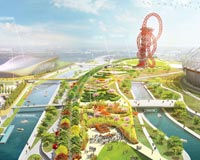So 2012 is finally upon us, and the next six months will be all bunting and breathless excitement as we focus on hosting the Olympics. Legacy, which played such a big part in selling the London games, will be forgotten. Until, that is, the day when the games end, the Olympic park closes for transformation, and all those grand legacy promises are finally exposed to the cold light of an approaching winter.
At which point we may uncomfortably recall that postwar Olympics are generally associated with negative rather than positive legacies (apart from Barcelona, of course, though arguably its reputation is as much down to a new airport, and the arrival of Easyjet, as to the Olympics).
Post-Olympics, legacy chatter will shift to the one tangible thing the games have left behind: that chunk of real estate, with state-of-the-art infrastructure and connections, next to Stratford.
The world, and posterity, will judge the success of the Olympics very simply, by how much long-term urban value London extracts from the site.
The key to success is simple – put the Olympics in the right place, where the city has clear long-term development ambitions that the market has credible self-interest in delivering, and where the Olympics is not the only trigger, but is sandwiched by longer-term public and private investment.
And this is what London, unusually, has done. Unusually, because London has tended to stumble into its big locational decisions largely by accident, generally involving noble but improbable, not to say inaccessible, locations further and further east. It is remarkable that the London Olympics didn’t end up in Dagenham Dock, or Erith Marshes
Stratford is London’s “right place”. The focus for London regeneration ambitions for more than 25 years at least, it has a real urban identity on which to build. Hence the Jubilee Line, high-speed rail station and Stratford City, all investment which preceded any whiff of an Olympic bid. And now with Crossrail to follow.
Stratford’s problem was that the massive potential development area which surrounded it was blighted by pylons, multiple and complex land ownership, and contamination. Development beyond Stratford City was outside the reach of any conventional regeneration programme. Until, that is, the Olympics arrived to provide the motivation, muscle and, yes, money to unlock it.
It will provide London with a resource unique among its world city competitors, a site just miles from Bank and Canary Wharf, set in waterside parkland, super-connected by road, rail and fibre, with state-of-the-art green infrastructure, basking in media attention.
Alongside this, the local boroughs have found their way into a quite inspiring new compact to begin to tackle the long-standing burden of inequality which east Londoners have had to put up with for – well, for centuries.
This is something special, not simply for the East End, but for London. This will be a contemporary location where London business can shed its skin and reshape its international offer for a challenging new century, and where even government and cultural institutions which have hitherto shunned east London might finally summon up the courage to dip their toe into the world beyond the River Lea. Already we have seen the Wellcome Trust circling, with an interest in establishing a world centre of excellence.
It is not all plain sailing. The Olympics have left the Olympic Park Legacy Company with a lot to do, the complexity of the athletics stadium being a case in point. Even after the £7bn Olympic investment, the site is still largely disconnected from its surroundings. No doubt the Treasury is leaning on the legacy company to generate immediate financial return regardless of the state of the market.
The dogged commitment of the GLA and the legacy company to yet another generic “new quarter for London” doesn’t help. The image of folksy “villages” doesn’t really work, dotted as they will be among looming sports arenas. Surely the premium of this site is its urbanity, not its suburbanity. Yes, London needs new housing, but slightly down-at-heel though very marketable houses with gardens already stretch out from the Olympic Park for miles in all directions. What this part of London fundamentally needs is a new economy.
Whatever happens with the site, the area will be full of cranes for the next few years – Olympic “transformation”, the remodelling of the Olympic village, building Crossrail, building out Stratford City Phase 2, development in the fringe, and so on.
“Legacy” is already happening. But if we allow ourselves to be creative and patient, we could go on to “out-Barcelona” Barcelona, even without the sun, and the Med (and let’s not mention the football team). This is the chance for the private sector to share in shaping London’s strategic future, if it wants to take it.
Ralph Ward is a former DCLG regeneration advisor for the Olympics and Thames Gateway and head of Lea Valley Projects for UK Regeneration











